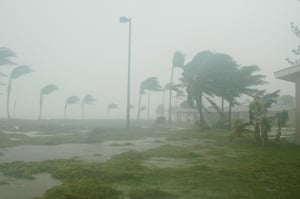If the first major hurricane of the season caught your business by surprise, you need to act quickly to remedy the situation for future storms. Hurricanes are not spur of the moment “pop-up” storms. Thanks to innovations in technology over the past 50 years, we are able to estimate when a hurricane will hit land, the strength of the storm, and the direction of its path. Of all of the recognized crises, hazards, and exposures your business can face – hurricanes have the most advanced warning. Having this knowledge gives you time to better prepare your people, your home, and your business.
Business hurricane preparedness will be very different than preparing your home. First and foremost, your organization is responsible for your employees’ and visitors’ safety. In addition, you have obligations to ensure the survival of the organization, reduce actual losses, decrease insurance exposures – and ultimately – ensure the best possible outcome for the worst possible situation. You need to take precautions before the storm gets stronger.
In keeping your business prepared for a hurricane emergency you must keep everyone up to date with accurate and ongoing communications. Making sure each person receives the correct information to keep them safe can be tricky, but training your employees on your hurricane emergency preparedness plan can help you to keep your people safe and informed – and ensure the survival of the business.
There are several key steps you can take to minimize damage to your business while at the same time keeping your people safe.
- - Monitor forecasts and share with your employees.
- - Validate your employee contact information is correct and conduct a test of your emergency notification system.
- - Protect all of your important records.
- - Secure all doors and windows.
- - Test your fire protection equipment.
- - Check functionality and gas levels on building generators.
- - Secure or shut down gas, chemicals, or flammable liquid pipes and secure tanks.
- - Move any outside equipment or items that could blow away and become projectiles.
- - Store bottled water and non-perishable food in a safe location for employees who may need to remain onsite during the storm.
- - Evacuate and close your business so your employees can prepare their homes and families.
Ensuring your employees know that you have their safety in mind can change the outlook of a bad situation like a hurricane. Reviewing not only your hurricane emergency preparedness and recovery plans with your employees, but also how they receive the alerts and what they should do once the alert is received will help to keep them safe. This should be reviewed and even exercised every quarter or every six months to help refresh your people with your safety plans.
It is also critical to prepare your emergency notification system with hurricane scenarios. You can use predefined templates and messages for emergency communication throughout the potential stages of a storm. You might not know all the details of what you’re going to say, but you know the Groups of people you want to alert and the gist of the message. Preparing this will save you time and energy as the hurricane could potentially impact your ability to sit down and draft messages on the fly. And remember to keep your employees informed after the storm. Communicating unsafe conditions, the progress of re-opening, and any other plans for moving forward are just as important.
When any emergency happens, response times are extremely important — which is why you need to make sure you have the right people involved from the start. Initiating collaboration with members of your Critical Communication Team (CCT) within the first few moments of an emergency allows you to be more agile and respond to issues as they occur, rather than working them up the chain of command. It is imperative that you assemble a team who will take the lead in developing and delivering critical communications when an emergency event occurs – including a hurricane. Once you have notified your people of the crisis and mobilized your resources — it’s just as important to collaborate with your CCT to discuss the next steps of the crisis management plan.
Ensuring your organization is prepared for hurricane season is something that needs to be done long before any hurricane comes near. Having those predefined messages and technological actions created is a necessity that you must invest time in. With proper planning, in alignment with your organization’s emergency notification and response plan, you can mitigate the risk and damage associated with a hurricane or other potential environmental hazard.
We have no idea how much damage will occur this hurricane season, but having your emergency notification system prepared and aligned with your emergency response and action plan gives you peace of mind you wouldn’t have had otherwise. It proves to your entire organization that you already know what steps and actions you’re going to take to keep everyone safe and protect the business.
To learn more about how you can better prepare your business for the recognized crises, hazards, and exposures all organizations face, download and read the white paper The Critical Communications Cycle.

